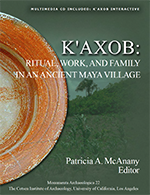By the end of the Classic period (around A.D. 900), the built environment of K'axob including two pyramid plazas and about 100 residential platforms, many of them grouped on top of large basal platforms. Labeled "A" and "B" on the map, the pyramid plazas are shown in their usual "bushy" state in the photos.


Pyramid Plaza A

Pyramid Plaza B
Our excavations (here called "operations") indicate that the ancestral heartland of K'axob was located in the southern sector of the site. Buried deeply beneath Plaza B and found at the base of operation 1, the earliest known K'axob domicile (a large, oval structure with an appended kitchen) was built around 600 B.C. or during the Middle Formative period. Domiciles built during the Late Formative and initial Early Classic periods (400 B.C. - A.D. 350) were plentiful at K'axob with examples excavated from all six operations conducted in the smaller, "satellite" platforms encircling Plaza B (clockwise from upper left: operation 11, operation 12, operation 13, operation 10, operation 8, and operation 7). Structures are visible as an arc or rectangular alignment of stones delimiting a prepared, packed-marl surface.


Operation 1

Operation 11

Operation 12

Operation 13

Operation 10

Operation 8

Operation 7
Previous page | Next page |
Reuse
Copyright holder: Patricia A. McAnany
License: Attribution-NonCommercial-ShareAlike 4.0 International (CC BY-NC-SA 4.0)
Recommended citation:
McAnany, Patricia A., 2004. Tour for K'axob: Ritual, Work, and Family in an Ancient Maya Village. Version 2. Cotsen Institute of Archaeology Press. https://doi.org/10.25346/S6/JYWFSW
Download data: tour.zip
